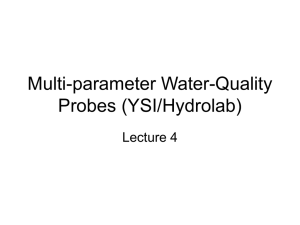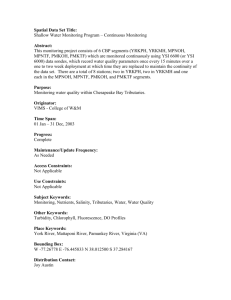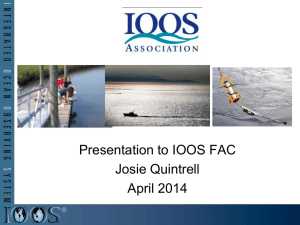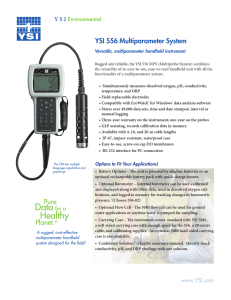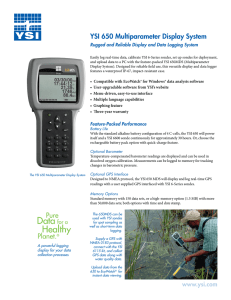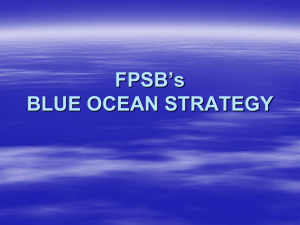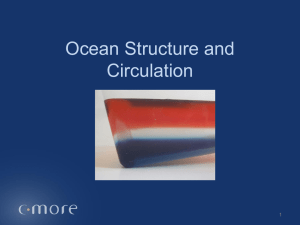U.S. IOOS Contributions to Monitoring Water
advertisement
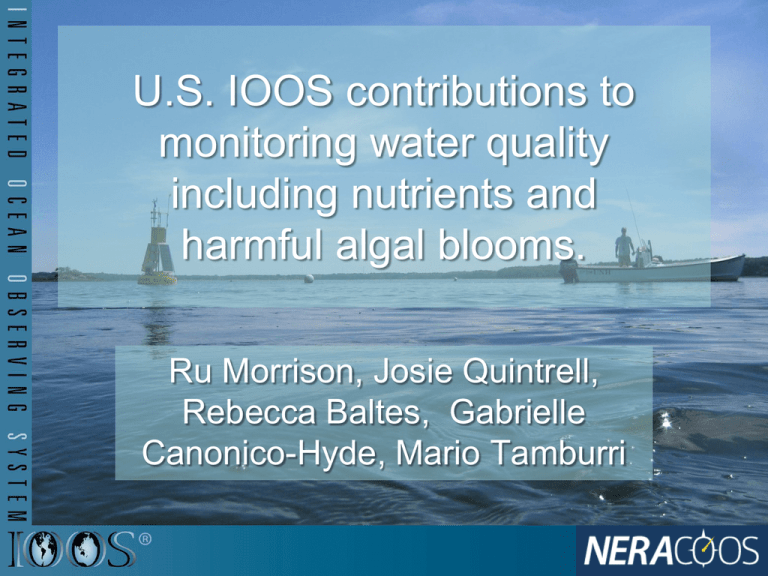
U.S. IOOS contributions to monitoring water quality including nutrients and harmful algal blooms. Ru Morrison, Josie Quintrell, Rebecca Baltes, Gabrielle Canonico-Hyde, Mario Tamburri US Integrated Ocean Observing System (IOOS) • A tool that enables the Nation to track, predict, manage and adapt to changes in our marine environment and delivers critical information to decision makers to… Improve safety Enhance our economy Protect our environment US Integrated Ocean Observing System (IOOS) Global Component: Global Ocean Observing System National Component: Composed of 17 U.S. Federal Agencies Education Regional Component: 11 Regional Associations IOOS National User Needs Synthesis Marine Operations Coastal, beach and nearshore hazards Ecosystems and Fisheries Water Quality Long term trends http://www.ioosassociation.org 4 Water Quality Water Quality 5 Performance Verifications/Demonstrations DO Sensors (2004) - Aanderaa (optode), Greenspan (galvanic cell), In-Situ (optode), YSI (Clark cell) Chl-a Fluorometers (2005) - bbe Moldaenke, Chelsea (2), Hydrolab, Turner (2), WET Labs, YSI Turbidity Sensors (2006) - Aquatec, In-Situ, McVan, WET Labs, YSI Nutrient Analyzers (2007) - American EcoTech, Satlantic, WET Labs, YSI C-T Sensors for In Situ Salinity (2008) - Aanderaa, Campbell, Falmouth, Greenspan, In-Situ, RBR, Rockland, YSI pCO2 Analyzers (2009/2010) - Contros, NOAA/PMEL (Battelle), Pro-Oceanus, Sunburst, YSI Hydrocarbon Sensors (2011) - Aquatec, Chelsea (3), Hach, S:can, Turner Designs, and WET Labs pH Sensors (2012/2013) - Aanderaa, Campbell, Idronaut, In-Situ, Satlantic, Sunburst, YSI Nutrients Performance Demonstrations Transitioning into operations Great Lakes Mooring Test: YSI 3 Nitrate+Nitrite (mgN/L) 2.5 2 1.5 1 0.5 0 10/1 10/3 10/5 Great Lakes Test:10/17 Wetlabs 10/7 10/9 10/11Mooring 10/13 10/15 10/19 10/21 10/23 10/25 10/27 Time 4.0 3.5 Phosphate-P (uM) 3.0 2.5 2.0 1.5 1.0 0.5 0.0 9/30 10/5 10/10 10/15 10/20 10/25 10/30 Time Mario Tamburri, tamburri@umces.edu Data source: N. N. Rabalais, Louisiana Universities Marine Consortium, and R. E. Turner, Louisiana State University Funding from: National Oceanic and Atmospheric Administration, Center for Sponsored Coastal Ocean Research http://www.gulfhypoxia.net Bottom-Water Hypoxia (< 2mg/L) July, 2007 20,500 km2, 7900 mi2 9,000 Area of Mid-Summer Bottom Water Hypoxia (Dissolved Oxygen < 2.0 mg/L) 8,000 6,000 5,000 4,000 3,000 2,000 1,000 0 n.d. Square miles 7,000 Data source: N.N. Rabalais, Louisiana Universities Marine Consortium, R.E. Turner, Louisiana State University Funded by: NOAA, Center for Sponsored Coastal Ocean Research Dissolved oxygen (mg l-1) Dissolved Oxygen at 20 m, Station C6C Wind mixing events Different responses at bottom June 2012 Data source: N. Rabalais, LUMCON Imaging FlowCytobot (IFCB) a continuous, automated phytoplankton imaging system • A new IFCB has been built and was deployed at UTMSI in August 2012 • The new design is smaller and lighter and more robust • Deployed “in the can” in pier lab for improved stability. Original design New design As deployed at UTMSI 9/2007-3/2012 Dr. Lisa Campbell, Texas A&M University Vandalism damage 2012 11 Early detection of HABs with IFCB • IFCB has provided early warning of 6 HAB events: no illnesses reported Dinophysis ovum Karenia brevis – Dinophysis ovum in 2008, 2010, 2011, 2012 – Karenia brevis in 2009 and 2011 • Campbell Lab has implemented automated downloading, processing, and classification • Early warning email notifications* are sent to TPWD and DSHS within 4 h of sampling if cell *not manually counts > 2/mL verified Ann Jochens Sample email message sent in 2011 Kelli Page and Jenn Read, GLOS Drinking Water Quality: Huron Erie Corridor Waterways Forecast System (HECWFS) Goal: • Reduce health risks and costs associated with pollutant spills in the Lake Huron to Lake Erie Corridor Major Elements: • Link 2d model for corridor to NOAA Great Lakes Forecasting System • Generate 3d public domain model • Use 3d model to support water intake risk assessment work SCCOOS and CeNCOOS Involvement with the 2012 Orange County Sanitation District (OCSD) Diversion http://www.sccoos.org/projects/ocsd-diversion/ Previous/Ongoing SCCOOS Water Quality Projects 1. 2006 City of Los Angeles Hyperion Ocean Outfall Diversion 2. Tijuana River Plume Tracking 3. Case Study: Areas of Special Biological Significance (ASBS) Danielle Williams and Julie Thomas, SCOOS Supporting Beach Swimming Advisory Decision Making Issue: Exposure to beach swimming waters with elevated bacterial levels is a public health concern and one of economic vitality. Goal: Develop and implement scientifically-justified, decision-support tools for accurate and defensible preemptive advisory issuance decisions. Process: 1.) Data integration and fusion 3.) Model validation Percent Misclassification Level 1 60% 50% 40% 30% 20% 10% 0% NMB2 NMB3 MB1 MB2 MB3 MB4 SS GC 2.) Ensemble model development 4.) Operational support tool Who is doing it: A partnership among beach managers, tourism interests, public health officials and the general public including… Current activities - Beach advisory modeling Dwayne Porter, porter@sc.edu U.S.IOOS Coastal Ocean Modeling Testbed, 2010-2012 Estuarine Hypoxia Shelf Hypoxia Salinity maps for coastal ROMS, NOAA GOM, NRL IASNFS and NRL/FSU HCOM Gulf, http://pong.tamu.edu /~mma/sura/anims_ models.php • Transitioning information to federal agencies • Model Comparison • Conducting sensitivity experiments • New, single term hypoxia model • • • • • Improving Collaboration Gulf of Maine / Scituate Harbor Improving Data Extratropical Domain Model Development Supporting Operations Biogeochemical operating equations transitioned to FVCOM community modeling group in CSDL 18 Helping develop nutrient criteria • NERACOOS Buoy Observations in the Great Bay Estuary, NH part of the strategy to develop nutrient criteria based on protecting eelgrass habitat • Provided important information on water clarity • Autonomous nutrient measurements • Nutrient monitoring an important part of new municipal waste treatment compliance 19 Thanks to: Acknowledgements – Josie Quintrell, Gabrielle Canonico-Hyde, Mario Tamburri, Becky Baltes, – Nancy Rabalais, Dwayne Porter, Kelli Page, Jenn Read, Ann Jochens – And everyone else from the IOOS Regions, Program Office, and Association who did all the real work!
